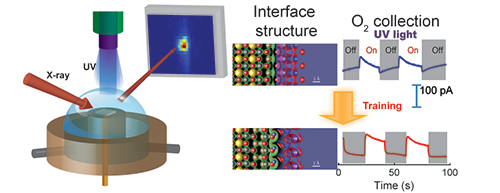X-RAY RUNS: Apply for Beamtime
2017 Nov 1 - Dec 21
2018 Feb 7 - Apr 3
2018 Proposal/BTR deadline: 12/1/17
2018 Apr 11 - Jun 4
2018 Proposal/BTR deadline: 2/1/18
Since the initial reports of the photo-assisted water splitting on n-SrTiO3 (STO) in the 1970’s, STO has become a great model system for the photocatalysis study. Extensive research studying the bulk and catalytic properties of STO as well as characterizing its surface structure in ultra-high vacuum and in atmosphere is in the literature. However, little is known about the structure of the STO/electrolyte interface under photocatalytic conditions, even less is known about the effect of surface structure on its catalytic properties. A recent work has been published in the Journal of the American Chemical Society, titled “Structure of the photo-catalytically active surface of SrTiO3”1, through the collaboration of several groups: Joel D. Brock, Héctor D. Abruña, Tomás A. Arias and Darrell G. Schlom groups from Cornell as well as Joaquín Rodríguez-López group from University of Illinois at Urbana-Champaign, discovering the missing bridge between the surface structure and catalytic activity of STO.
The in situ surface X-ray diffraction (SXRD) measurements were performed on STO (001) during photocatalytic water splitting at the A2 beamline of CHESS. By combined in situ SXRD measurements with novel first-principles joint density-functional theory simulation2, the structure of the photochemical active surface on STO (001) in the electrolyte and under water splitting conditions was determined. Two novel surface structures of STO, before and after electrochemical “training” were found. Further, through simultaneous electrochemical measurements with scanning electrochemical microscopy3, we show that the change of surface structure leads to a three-fold increase of the activity towards the photo-induced water splitting.

Figure (left) experimental setup of in situ surface X-ray reflectivity measurement; (right) the JDFT calculated atomic mode and SECM collection while cycling UV illumination for (up) untrained surface and (down) trained surface.
References:
[1] Plaza, M., Huang, X., Ko, J. Y. P., Shen, M., Simpson, B. H., Rodríguez-López, J., Ritzert, N. L., Letchworth-Weaver, K., Gunceler, D., Schlom, D. G., Arias, T. A., Brock, J. D. & Abruña, H. D. Structure of the Photo-catalytically Active Surface of SrTiO3. J. Am. Chem. Soc. 138, 7816-7819, (2016).
[2] Petrosyan, S. A., Briere, J. F., Roundy, D. & Arias, T. A. Joint density-functional theory for electronic structure of solvated systems. Phys Rev B 75, (2007).
[3] Rodríguez-López, J., Zoski, C. G. & Bard, A. J. in Scanning Electrochemical Microscopy (eds A.J. Bard & M.V. Mirkin) Ch. 16, (CRC 3Press, 2012).
Submitted by: Xin Huang, Cornell University
07/27/2016
